The George Sawyer Mokume Color Palette
Here are some simple points about our mokume color palette
to help you pick your perfect mokume color combination.
When visiting your nearest retailer, the examples in their showcase may not match the colors shown here. Computer monitors vary greatly in their color representation. Also, the ring samples in the case have been handled many, many times and the metals can tarnish over time, especially sterling silver. Rest assured, the rings you order will arrive brand spankin’ clean straight from the goldsmith’s bench. Daily wear and occasional cleaning will keep them looking beautiful for years to come.
“A” Color

“A” Color combination is made of 14k yellow and red gold, sterling silver and etched copper. This is the original gold mokume color combination and still one of my favorites. It has strong color and dimensional definition with layers of 14k yellow gold, 14k red gold, sterling silver and copper, both etched. There is a nice color balance between all of the colors, with a slight bias toward the reds. The white silver tracing through the reds and yellows contributes a delicacy to the pattern. Since it has two non-gold layers, it is a less expensive mokume color combination. “A” does not have an 18k equivalent.
“B” Color

“B” Color combination is made of 14k yellow, red and gray gold with etched copper. “B” mokume is our most popular color combination. It has a little more subtle color tone than “A” because of the rich gray color of our palladium gray gold alloy. Etched copper layers frame the gray gold layer as it circulates through the pattern, giving this combination a distinct, rich red color tone. Composed of 14k yellow, red, and gray golds, with etched copper, it has stronger color contrasts that its 18k equivalent, “E”.
“C” Color

“C” Color combination is made of 14k yellow, red and gray gold with etched sterling silver. “C” color mokume runs a close second in popularity to our “B” mokume. It has a soft, light color tone with its cool white and gray colors warmed by pastel yellow and pink tones. 14k palladium gray gold and etched sterling silver give “C” mokume its dominant whiter colors and dimensional definition while 14k yellow and red golds provide the warmth. “C” mokume has a crisper color contrast than “F”, its 18k equivalent.
“D” Color

“D” Color combination is made of 14k yellow, red and gray gold with a smooth , non-etched surface. The “D” mokume color is the most subtle of all the mokume colors. When worn to a smooth surface, its color pattern may only be perceivable to those close to its owner, making it a very personal statement. “D” mokume’s subtlety is due to its all 14k gold construction, its complexities defined only by color. There are no dimensional etched lines to define the 14k yellow, red, and gray gold colors, so only the discerning eye will discover its secrets. “D” mokume’s bolder 18k counterpart is “G”.
“E” Color

“E” Color combination is made of 18k yellow, red and gray gold with etched copper. The “E” mokume combination has a warm, rich color tone with a soft color contrast. While the 18k palladium gray gold and etched copper layers define this material very cleanly, the “golder” color of the 18k yellow gold and the slight gold cast to the 18k red gold lend a richer, softer feel to the whole mix. The rich color combination of 18k yellow gold and deep red copper is especially attractive. Comparing the 18k “E” to the 14k equivalent “B” is a bit like comparing softness to crispness.
“F” Color

“F” Color combination is made of 18k yellow, red and gray gold with etched sterling silver. “F” color mokume has well defined, etched, dimensional pattern-work. Its intensely colored 18k yellow gold provides a strong color contrast to the gray gold and sterling silver, and softens the harder edged cool colors. The high karat “gold” colors of the 18kt yellow and red gold give the “F” color mokume a softer, richer, warmer color tone than “C”, its lighter, cooler colored 14kt equivalent.
“G” Color

“G” Color combination is made of 18k yellow, red and gray gold with a smooth, non-etched surface. The “G” color mokume has a balanced color tone, with a slight bias toward the 18k yellow gold color. The high karat gold color of the 18k yellow provides a strong enough color contrast with the red and gray gold to make the pattern quite visible even with no etching. The pattern in “G” mokume is much more visible and has a much richer color tone than “D”, its 14k equivalent.
“H” Color

“H” Color combination is made of 14k green, red and gray gold with a smooth, non-etched surface. The “H” mokume combination has a wonderful light feeling. The pastel green gold contrasts with the red gold beautifully, accentuating the visibility of the pattern. Better yet, the green and red gold mutually enhance each other’s colors, making the red look redder and the green look greener. The gray gold provides some strong pattern definition and “plays” very well with the red gold. This is one of my favorite combinations. “H” color mokume has a more visible pattern than the 18k “G” and a much more visible pattern than its 14k equivalent “D”.
“J” Color

“J” Color combination is made of 14k gray gold and etched sterling silver. “J” mokume is the boldest of our combinations. The color contrast between the 14k palladium gray gold and the white silver is enhanced even further by increasing the width of the individual metal layers in the pattern. There is a little “softness” imparted by the rich gray color but the lack of any “warm” colors in the mix makes “J” a very cool character. The “J” combination’s lack of color provides a great foundation for detail work done in strong, warm colors like 22k yellow gold or 14kt red gold. Our special 14k palladium gray gold alloy provides the strongest color contrast to white sterling silver, so there is no 18k color equivalent. The 18k K is graphically similar to “J” and “L”, our palladium 500, provides an alternative option.
“K” Color

“K” Color combination is made of 18k yellow and 14k gray gold with a s mooth, non-etched surface. “K” pattern mokume is bold, warm and simple. It has the same wide pattern layers as “J”, but the 18k yellow gold imparts a soft, rich warmth. The two color composition gives a graphic clarity to “K” that works especially well in symmetrical pattern-work to create remarkable abstract images. 14k “J” is graphically similar, but with different colors.
“L” Color

“L” Color combination is made of Palladium 500 and etched sterling silver.”L” is very similar to our “J” combination. The color contrast between the palladium 500 and the white silver is enhanced even further by increasing the width of the individual metal layers in the pattern. There is a little “softness” imparted by the rich gray color but the lack of any “warm” colors in the mix makes “L” a very cool character. This combinations gray gold equivalent is “J”.
Some Interesting Notes on Copper and Silver Pattern Layers
Since color and pattern are of primary importance in our mokume, we use copper and sterling silver as well as gold in some of our color combinations. Copper is the reddest metal and silver the whitest. They provide a strong color contrast to the generally more pastel colors of gold alloys. Unlike most gold alloys, copper and silver can be acid etched. When used with gold in a mokume color combination and etched, they provide a much bolder, more visible pattern than gold alloys alone. Over time, the copper layer can continue to recess deeper into the surface of the pattern, creating a beautiful ancient appearance.
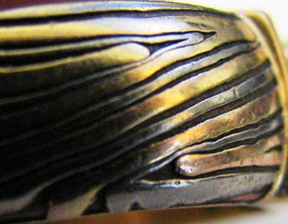
This appearance is the essence of wabi sabi, the Japanese art of finding beauty in imperfection and profundity in nature. It celebrates cracks and crevices and all the other marks that time, weather and loving use leave behind.
In the color palette, we show copper in its natural unoxidized state, but copper also is interesting in that it can change color in daily use. When a mokume ring is new, the copper is metallic pink, but the color can change with daily wear. We are all familiar with copper turning green, but it can also turn turquoise blue, brick-orange, shades of brown and even red, depending on the wearer and the environment. These interesting colors are not permanent, but will usually remain in the etched, protected areas. Some of these oxide colors will occasionally rub off on your finger, but the color can be wiped off. Please note that on very rare occasions, copper can cause an allergic reaction with certain individuals.



All of the mokume colors are created in George Sawyer’s signature Edge Grain Mokume technique and all are available with Mirror Image™ pattern matching.
Appreciating the Beauty of Hand-Crafted Jewelry
All George Sawyer jewelry is carefully handmade from beginning to end in our Minneapolis studio. Each billet of mokume is hand-forged, creating an ever-changing painting in gold. Every set of rings is hand fabricated from beginning to end by one goldsmith and all orders are carefully inspected for quality.

The proportion and color balance of metals is the same in every ring, but the details of the pattern are unique to each pair of mirror image rings.
Each pattern has a rhythm of calm and complexity, excitement and peace.
George Sawyer customers love the fact that their rings were truly made just for them and appreciate the handcrafted quality and individuality of the work.
If you already wear a comfortable ring on the same finger as your new George Sawyer ring, take it to your retailer – they can determine its size.
If you do not have a ring that fits comfortably, your retailer can accurately measure your finger.
If you are ordering online through the George Sawyer Gallery, we will send a plastic ring sizer with instructions for proper sizing. You may also want to visit a trusted local jeweler who can size your finger or an existing ring.

We measure rings to the center line, not the leading edge.
This ring is a size 10 1/4, not 10 1/2.
The goldsmiths at George Sawyer are the only ones in the world qualified to work on our highly specialized metals and designs. We can size and repair most rings without interrupting the pattern or changing the mirror image.
Please remember, if someone outside our studio alters one of our designs inany way, we can no longer be responsible for the craftsmanship or integrity of the piece and will not accept it for any future work.
“George Sawyer rings are made to be worn for a lifetime
and take on the personality of the owner”

All George Sawyer pieces are shipped with a matte finish. After wearing for several weeks or months, the ring develops a patina unique to the wearer. Frequency of wearing, metal combination, left- vs. right-hand and even body chemistry can personalize your ring’s patina.
It’s possible to refinish the ring periodically, but not necessary. A soft toothbrush and warm soapy water or a professional ultrasonic and steam should take care of any surface dirt or oils.
Salt Water and jewelry don’t mix. Ocean water can damage some stones and metal. Chlorine and bleach accelerate tarnishing and should be avoided. No rings in the ocean or hot tub, kids!
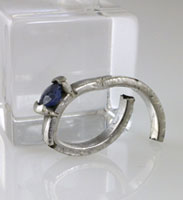



The goldsmiths at George Sawyer are the only ones in the world qualified to work on our highly specialized metals and designs. We can size and repair most rings without interrupting the pattern or changing the mirror image. But, please – stay out of that garbage disposal!!
If someone outside our studio in any way alters one of our pieces, we can no longer be responsible for the craftsmanship or integrity of the piece and will not accept it for any future work.
 At George Sawyer we care about the integrity of the metals and stones in the jewelry we make. We purchase all of our metals from metal refiners who are SCS Certified Responsible Refiners or the majority of whose metals are recycled. We recycle all our metal scrap – even the contents of our vacuum cleaner bags are recycled. Our stones are purchased from legitimate sources not involved in funding conflict and in compliance with United Nations resolutions. We guarantee that the stones used in all George Sawyer jewelry are conflict-free, based on personal knowledge and written guarantees provided by the supplier of these stones. We donate to the Diamond Development Initiative International which works to ensure an ethical supply chain of diamonds.
At George Sawyer we care about the integrity of the metals and stones in the jewelry we make. We purchase all of our metals from metal refiners who are SCS Certified Responsible Refiners or the majority of whose metals are recycled. We recycle all our metal scrap – even the contents of our vacuum cleaner bags are recycled. Our stones are purchased from legitimate sources not involved in funding conflict and in compliance with United Nations resolutions. We guarantee that the stones used in all George Sawyer jewelry are conflict-free, based on personal knowledge and written guarantees provided by the supplier of these stones. We donate to the Diamond Development Initiative International which works to ensure an ethical supply chain of diamonds.

- George’s signature and date the ring was made are inscribed on every piece.
- Copyright symbol. Each George Sawyer design is protected by copyright.
- George Sawyer’s trademark symbol. It is your guarantee that this piece is an original George Sawyer design.
- Metal content, listed in order by percent of weight.
- Each ring or set of rings is made by one goldsmith from beginning to end. Our goldsmiths take great pride in their work and every ring bears the initial of the goldsmith that made it.
We accept Cash, Checks and Credit Cards for payment. If you are ordering a made-to-order piece, 50% of the purchase price will be charged to your account when you place the order, the balance upon shipment. If you are ordering a completed piece, the full purchase price will be charged to your account on the shipping date.
Important diamond information
The diamonds used in George’s designs are purchased from legitimate sources not involved in funding conflict and in compliance with United Nations resolutions. We only buy from diamond suppliers that guarantee the diamonds are conflict free, based on personal knowledge and/or written guarantees provided by the supplier of these diamonds.
Center stones
 Your ring will be built for your specific stone. We will begin making your ring after we receive your stone.
Your ring will be built for your specific stone. We will begin making your ring after we receive your stone.
You or your retailer can provide the stone, or we can source one for you.
We do not ship unset (semi-mount) rings. Our specialized metals and designs require us to do all stone setting in our studio.
Insurance is highly recommended for all stones. This protects you against loss due to theft or breakage. We will take all precautions necessary to safely set your stone. However, on very rare occasions, damage can occur and we cannot be held responsible for replacement or repair.
Flush set and channel set stones
 We use D-E-F, VS1/VS2 quality diamonds in all channel set and flush set designs.
We use D-E-F, VS1/VS2 quality diamonds in all channel set and flush set designs.
Our channels require small diamonds of very specific dimensions. It is not possible to set a customer’s stones in a channel.
However, it is sometimes possible to flush set a customer’s stones. Your retailer can call for details.

- So only gold touches the ring finger
- To produce a smooth, polished finish on the inner surface.
- To allow rings to be produced in any finger size.
Since the slices of mokume used to make our rings are a consistent thickness and length, the gold lining provides the extra material necessary to make every ring the same thickness, regardless of finger size. This allows us to create sets of rings with uninterrupted patterns and mirror images, even those with very different finger sizes.
The standard thickness for all rings is approximately 2mm.
The color and karat of the gold lining is consistent with the mokume combination chosen.
Occasionally customers request a different color or karat liner. We will do everything we can to accommodate these requests.
Planning your perfect set!

When the billet of mokume is cut, each slice has a slightly different pattern. But when two adjacent slices are placed side by side, their cut faces reveal an exact Mirror Image™ of each other. Those adjacent slices, and the rings made from them, are the only ones in the world that will match each other exactly.

A three ring set can be mirrored, too! Want a three ring set but can’t swing the whole deal right now? We can make your engagement ring today and for a small fee we’ll reserve your matching slices of mokume. When you’re ready to order your wedding rings the reserved slices will be used to complete your Mirror Image™ set.
Most ring styles use a full width slice of mokume. A few styles use a half slice:
- 3.6mm half round and flat bands
- stone settings built on 3.6mm half round and flat bands
- 6mm and 7mm round edge bands

Full slices have a full knot or “dot”
Half slices have a half knot or “dot”
 “Edge Grain” mokume is the most durable mokume, with the cleanest definition and greatest variety of pattern. “Edge Grain” mokume is a George Sawyer original technique used in all George Sawyer mokume pieces.
“Edge Grain” mokume is the most durable mokume, with the cleanest definition and greatest variety of pattern. “Edge Grain” mokume is a George Sawyer original technique used in all George Sawyer mokume pieces.
Unless there is a design reason for a break in the pattern, the pattern should be continuous and unbroken all the way around the ring, with no disruption from seams, sizing, etc.
If there is a silver, copper or copper alloy layer in the mokume, the ring should be fully lined to prevent the finger from discoloring.

The effect of natural electrolysis or corrosion on copper, shakudo and some other non-gold metals can cause flaking of the surface in twist pattern, star pattern and some other generic mokume styles.
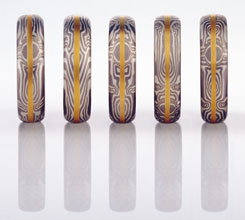
Patinas on shakudo, copper, copper alloys, silver or gold are delicate and will not survive on a ring.
Pattern line and color work should be distinct and crisp. There should be no fuzzy lines between color layers.
Pattern work and sculptural design should be unique to each maker, as distinct as a signature. Avoid knock-offs and generic material.
Look for high quality goldsmithing techniques, with balance and harmony between the pattern work and sculptural shape of the entire piece.

No nickel should be in white gold or any other metal alloys used in the ring. Nickel causes more allergic reactions in wearers than any other metal.
A mokume ring should have the heft, feel and weight of quality jewelry. Thin rings and rings made with thin mokume veneers will have durability and strength problems.
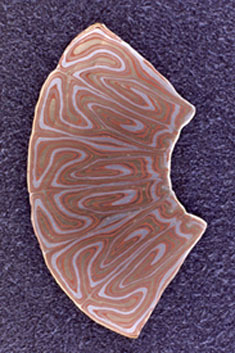
Making a great piece of original pattern mokume is very difficult and very technical. Once made, this material is even more difficult to work than traditional precious metals.
Designing and making original, artful objects and the occasional piece of real art with mokume is tougher still. The result is that the masters of this material, worldwide, can easily be counted on the fingers of one hand.
 The quality of mokume objects must be judged using both the criteria used to judge the three-dimensional art of the goldsmith:
The quality of mokume objects must be judged using both the criteria used to judge the three-dimensional art of the goldsmith:
- originality
- artistic vision
- identifiable style
- quality of execution
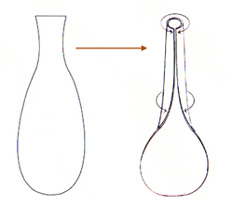 as well as the criteria used to judge the two-dimensional art of surface pattern design:
as well as the criteria used to judge the two-dimensional art of surface pattern design:
- meaningful, painterly pattern
- clarity and fineness of line
- seamless pattern work
- appropriateness of metals and colors
- harmony between pattern and sculptural shape.
 Mokume is a material much like fabric. It can be an intricate tapestry woven with thoughtful attention to color and pattern – or scratchy burlap, without nuance or beauty. The maker’s skill is evident in the beauty of the mokume and the objects made from it.
Mokume is a material much like fabric. It can be an intricate tapestry woven with thoughtful attention to color and pattern – or scratchy burlap, without nuance or beauty. The maker’s skill is evident in the beauty of the mokume and the objects made from it.
This orientation of the pattern layers permits very high quality pattern work and a great deal of latitude in creating the graphic design of the pattern.
“Edge Grain” mokume is a George Sawyer original technique used in all George Sawyer mokume pieces.

Cross-section of an etched ring
What are some of the advantages of using ‘Edge Grain’ Mokume over other patterning techniques?
- A distinct “look” unlike any other mokume
- Finer and more crisply defined line work, with brushstroke-like graduation in line thickness
- Mirror Image™ rings with one-of-a-kind pattern matches
- Complex symmetrical patterns
- Deep acid etching is a design option
- Superior pattern durability
- Copper and patinable copper alloys may be used in all applications without the risk of damage from electrolysis or corrosion
- To a greater or lesser extent, the color detail on twist pattern, star pattern, and virtually all non”Edge Grain” mokume is a surface pattern made up of very thin layers parallel to the top surface of the metal. Abrasion, corrosion, repairs and even simple wear over time can remove entire layers and complete patterns from the surface of rings made with these techniques.
Patinas – Delicious but Delicate

A patina is the chemical coloration of the surface of a metal. It can be natural, like the green on an old copper roof or it can be purposely applied as you see on bronze statues and art objects.

Patina work is an an art in itself and there are hundreds of patina formulas for use on scores of metals. Special metal alloys likeshakudo, shibuichi and kuromido were developed in Japan over the centuries especially for their beautiful colors when patinated.
Patinas can bring a metal surface to life in a way that puts the raw color of a metal to shame. The 24k gold moon on this brooch hangs in a purple-black patinated shakudo sky.

I use patinas on the top surfaces of art objects and some jewelry pieces, like brooches, that will not be exposed to constant contact with the skin, abrasion or heavy wear.
Patinas are not appropriate for all rings. They are only applied to deeply etched or protected areas of rings to prevent damage from daily abrasion and skin contact.

- Color – Silver is the whitest metal and copper is the reddest.

- Etchability – Silver and copper can both be acid etched, allowing us to make color patterns very dimensional, with the copper and silver color lines at lower levels than the golds.

- Color change – Silver and especially copper can change color when they are exposed to moisture, salt and other materials, sometimes even when exposed to the slight differences in the skin chemistry between individuals. With silver and copper, the rings actually can subtly change color when worn by a different person or when you encounter something new in your environment.

“Color always trumps karat” in my mokume. Each karat alloy has its unique color and the alloys are my “paints”. I’ll use 14k red gold, copper, sterling silver and 18k yellow gold in one piece or 14k gray gold, 22k yellow gold and sterling silver in another to create a particular color effect.
 An alloy is a metal that is a combination of two or more elements. Alloys of gold can be shades of yellow, red, gray, green, peach, even violet, but all are not suitable for making mokume.
An alloy is a metal that is a combination of two or more elements. Alloys of gold can be shades of yellow, red, gray, green, peach, even violet, but all are not suitable for making mokume.
Pure 24k gold is always the same color – gold. But, since pure gold is so soft that it is rarely used to make jewelry for everyday wear, it is usually mixed (or “alloyed”) with other metals to make it harder. If the alloy is 75% gold and 25% other metal the result is called 18k gold. If the alloy is 58.5% gold and 41.5% other metal, the result is called 14k gold.
By using strongly colored alloying metals to mix with the gold, you can create colored gold alloys. Red gold is an alloy of gold and copper, and since 14k red gold has more copper in it than 18k red gold, it is redder.

